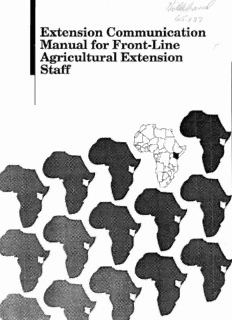
Extension Communication Manual for Front-Line Agricultural Extension Staff PDF
Preview Extension Communication Manual for Front-Line Agricultural Extension Staff
~ {,s; /37 Extension Communication Manual for Front-Line r Agricultural Extension Staff Extension Communication Manual for Front·Line Agricultural Extension Staff By John Fox 1990 Prepared for the On-Farm Grain Storage Project USAID Project No 615-0190 DPRA Incorporated Manhattan, Kansas, USA (Co..tr.etorfi.-I Project funded by USAIDlKeD~'a and sponsored by tbe Kenya Ministry ofAtricuItua-e No parta ofthis manual may be reproduced, except by the Kenya Agricultural Extension Services Staff in the direct performance ofits duties, without written permission. Forward To achieve the government's objective of food self-sufficiency, Kenya's farmers must increase food production and ensure its proper preservation in order to satisfy the rapidly increasing population. TheOn-FarmGrainStorage Project,sponsored by the Ministry of Agriculture, is introducing improved grain storage management technology to the small-scale fanners. One of the efforts ofachieving this aim is through the reduction oflosses to rodents,birds, mouldsandinsects. Theseloss!)s,whichcould reach 25%or more, occur in farms from the time grain reaches maturity in the field until it is consumed. The project was initiated in 1983 using the regular agricultural eltension services to disseminate the technologies to the farmers. The field extension workers arc expected to accomplish this by working with individuals, and sometimes by organizing field days attended by large groups oHarmers, Having only a minimum oftraining in extension communication skills, few reference materials,and practicallynovisual aids, some afthe Agricultural Assistants have not been able to communicate the project's and other messages as effectively as the Ministry would like. The Ministry hopes, therefore, that through this extension communication manual, the effectiveness of the front· line extensions workers will be significantly increased. This manual will also be useful at the Institutes of Agriculture, whichare responsible for trainingthefuture frontline agricultural extension workers. E. K. Kandie DirectorofAgrU:/J.lture , Preface The On~FannGrain Storage Projectis pleased to make thisexten sioncommunication manual available toKenya's MinistryofAgri culture. It is hoped that this practical guide will serve Kenya's front-line agricultural extension stafffor many years. The front-line workers are general agriculturalists and they must deliver information to fanners on a wide range ofsubjects. Their elTectiveness in this task depend6both on theirknowledge ortneir subjects and on their ability to communicate with farmers. The author speaks directly to the front-line workers. And the suggested methods and techniques should have application in the communication of subjects across the full range of agricultural extension-notjustpost-harvestmanagement. Likewise.theinfor mation contained in the manual should be ofuse to those educa tional institutions which train Kenya's agricultural extension staff, Also, the manual will have relevance for extension staffin other countries. The author, John Fox, has nearly thirty years experience in adult education and extensioncommunication. Hehas taughtcommuni cation skills, conducted research programmes, produced simula tions and games, video training tapes and previous handbooks on communication, He has over ten years of work experience with various professional groups in Kenya and otherAfrican countries. He spent two years teaching communication and adult education skills at the UniversityofNairobi'sAdultStudies Centre, Kikuyu. In preparation for this manual, John Fox accompanied front·line extensionworkerson theirdailyfarmvisitstogainclose,first hand eltperience oftheir work routines and interactions with farmers and hehasattended numerousprojectfie1ddaysin western Kenya. Thechapters follow a logical pattern.The first liveeltplorethecase foremployinga discussion andaction-basedmethodologyin exten sion work; the following chapters show how this methodology can be applied in a variety ofsituations and formats. The agricultural extensionworkerswho read thismanual will find guidelines and checklists for individual application. But the man ual alsocontains material thatcan be adapted for roleplayingand discussions in training groups. Dr. Walter G. Reid, Jr Team Leader, DPRA .. On-Farm Grain Storage Project Contents , INTRODUCTION , AGRlCULTURAL E:XTENSION: A SfATEMENTOF PRINCIPLES 1. WHAT IS COMMUNICATION? 3 An Dlustration The Main Considerations ACommunication Model The Characteristics ofGood Communication 2. THE FRONTLINE EXTENSION WORKER " Working Within the Training and Visit System ACompetency Analysis ACompetency List for the Communication Aspects of Extension Work •• FARMERS " Pressure Points The Adoption Curve •• THE LEARNING PROCESS 33 The Crucial Conditions for Learning Adults as Learners Implications •• MODELS OF EXTENSIONCOMMUNICATION , " Three Modes ofCommunication Choosing the Mode jii Contents 6. VISITING AFARM " Planning a Visit Meeting the Fanner Relating Lines ofCommunication Practising Skills Following Up The Advantages ofFann Visits Recording a Visit Checklist for Preparing a Visit Checklist for Evaluating a Visit 7. GIVING A TALK " The Meeting Place Planning a Talk Notes Persuasion Setting the Climate Appearance Gestures The Eyes The Voice The Basic Qualities of Effective Speaking Checklist for Giving a Talk 8. CONDUCTING ADEMONSTRATION 87 Involving the Farmers Focusing Demonstrating Summarizing Following Up Checklist for Evaluating a Demonstration Contents 9. LEADINGADISCUSSION Expected Behaviour in Groups Some Reasons for Working with Groups The Discussion Process Leading an Wormal DisC11lIsion Group OrganizingGroup Discussions The Conditions for Effective Discussion 1>, 10. USING PROBLEM SOLVING TECHNIQUES Force Field Analysis Brainstonning 11. USINGVlSUALAIDS Why Use Visuals? What Makes a Good Visual Aid? How to Present Visuals Which Aid to Use? Checklist ofVisual Aids A Note on UsingFilm and Video Recordings-or Radio Making Your Own Visual Aids F1ipcharts POSTSCIDPT ANNEX_The On-Farm Grain Storage PI-oject '" "
Description: